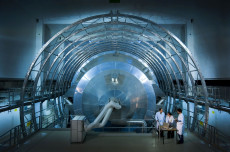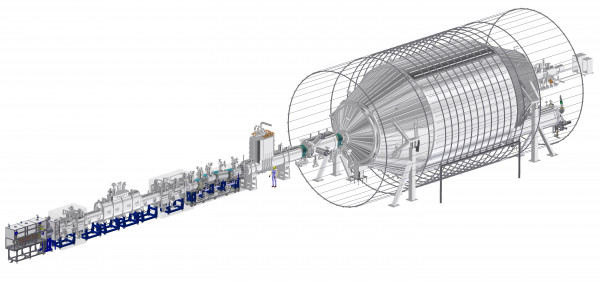NERSC Resources Help Achieve Milestone in Neutrino Research
KATRIN Project Establishes New Upper Limit for Neutrino Mass
February 14, 2022

Experimental hall of the KATRIN experiment showing the main spectrometer from the front. The outside rings are air-coil magnets used to compensate for the earth's magnetic field. (Credit: KIT/Markus Breig)
Researchers from Lawrence Berkeley National Laboratory (Berkeley Lab) and supercomputing resources at the National Energy Research Scientific Computing Center (NERSC) played a key role in helping an international team achieve a significant new milestone in the study of neutrinos and their mass. These extremely light subatomic particles were once thought to be beyond measurement.
This ground-breaking study, led by the Karlsruhe Tritium Neutrino Experiment (KATRIN) at Germany’s Karlsruhe Institute of Technology (KIT) and published Feb. 14 in Nature Physics, establishes a new upper limit of 0.8 eV/c^2 for the mass of the neutrino (eV = electron volts). For comparison, a neutrino is at least 10 billion, billion, billion times lighter than a grain of sand. This new finding is expected to pave the way for future discoveries in nuclear and particle physics and cosmology.
Despite their imperceptibility to human sensations, and to all but the most sensitive of measurements, neutrinos have implications for how the world functions at the level of elementary particles. The precise nature of the neutrino thus has wide implications in how the various pieces and forces of our universe fit together. According to the KATRIN team, this is the first time that a direct neutrino mass experiment has entered the sub-eV mass range, where the fundamental mass scale of neutrinos is suspected to reside.
Some of the statistical analysis used to determine the neutrino mass for the Nature Physics study was performed using the Cori supercomputer at NERSC, a U.S. Department of Energy Office of Science user facility located at Berkeley Lab. Bjoern Lehnert, a postdoctoral researcher in Berkeley Lab’s Nuclear Science Division (NSD) and a member of NSD’s KATRIN group, led the U.S. data analysis effort. Through precise calculations using C++ code – a general-purpose programming language – in a Shifter container, the researchers were able to lower the maximum possible mass of a neutrino from 1.1 eV/c^2 to 0.8 eV/c^2. The statistical analysis was done using the Bayesian Analysis Toolkit for roughly 800,000 CPU hours, Lehnert explained.
“The experiment we are doing is directly in the laboratory, where we can control everything,” said Lehnert. “It's what we call ‘model-independent,’ and it’s the best constraint we have from this type of experiment.” Model-dependent methods have produced lower figures, but those calculations are based on a particular set of assumptions.
Without the resources and support made available by NERSC, the Bayesian analysis “would have been very difficult,” said Alan Poon, NSD deputy division director for science and NSD’s KATRIN group leader. NSD researchers played a key role in this latest study of neutrino mass.
Detecting Atomic Phenomena
This finding is the latest achievement to come out of KATRIN, a massive experimental undertaking that took nearly two decades to plan, construct, and assemble. Much of the equipment and technology invented for KATRIN has already been put into use by other physics studies, meaning that KATRIN had advanced the field even before it was turned on.

In the 70 meter-long beamline of the KATRIN experiment electrons are emitted from the source on the left and guided into the main spectrometer on the right. Only those with high enough energy reach the end of the beamline to be counted by the detector system on the far right. Precisely measuring the electrons with the highest energies makes it possible to infer the mass of the neutrino. (Credit: KIT/KATRIN Collaboration)
The data produced by KATRIN is essential to establishing a lower maximum neutrino mass through direct measurements. Due to the challenge of making direct measurements on neutrinos, data quantity is the most defining factor in our knowledge of this fundamental particle.
“Statistics increases linearly over time but the sensitivity to the neutrino mass improves much slower,” Poon said. “So that's why, from this point on, it's going to take a lot more data to even halve our limit.”
While the data produced by KATRIN is relatively simple (“I can put it on a USB drive,” Lehnert said), the various contingencies that must be calculated in order to make determinations about the mass of a neutrino require immense computing power. While neutrinos are not measured directly by KATRIN, the neutrino mass can be deduced through the electron energy distribution as each tritium atom decays into helium, an electron, and an anti-neutrino.
“The large amount of computing power is needed mainly because of the systematic uncertainties, and that requires a lot of iterations,” Lehnert said.
NERSC and the Neutrino
NERSC has a long history of aiding neutrino studies; in the 1990s and 2000s, scientists collected data from the Sudbury Neutrino Observatory (SNO) – an 18-meter diameter metal ball, submerged 6,800 feet underground containing 1,000 tons of heavy water, packed with highly sensitive light sensors. This elaborate apparatus could detect individual neutrinos. The data produced at SNO was analyzed at NERSC by Poon and other researchers, who found that neutrinos change between their three types, or “flavors.” Only particles with mass can do this, leading to the key finding that neutrinos have mass. Researchers from SNO and from Super-Kamiokande Collaboration in Japan were jointly awarded the 2015 Nobel Prize in Physics for this work. This historical SNO data is archived at NERSC.
“NERSC figured pretty high in this accomplishment in the Nobel Prize because we were using NERSC facilities to process the data, to do the analysis, and to simulate the data for analysis,” said Poon. NERSC has also played a significant role in supporting the Daya Bay, KamLAND and Ice Cube neutrino experiments, he added.
The KATRIN collaboration and its U.S. contingent – including Berkeley Lab, the University of Washington, the University of North Carolina, and Carnegie Mellon University – plan to collect data from KATRIN for three more years. As they add to this crucial data set and forge it into conclusions using NERSC, they have a goal of pushing down the maximum neutrino mass to 0.2eV. As the neutrino’s mass comes into focus, physicists can take on even more fundamental questions, including why particles have the particular masses that they do.
About Computing Sciences at Berkeley Lab
High performance computing plays a critical role in scientific discovery. Researchers increasingly rely on advances in computer science, mathematics, computational science, data science, and large-scale computing and networking to increase our understanding of ourselves, our planet, and our universe. Berkeley Lab’s Computing Sciences Area researches, develops, and deploys new foundations, tools, and technologies to meet these needs and to advance research across a broad range of scientific disciplines.







 Instagram
Instagram YouTube
YouTube